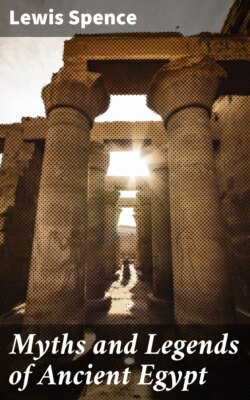Читать книгу Myths and Legends of Ancient Egypt - Lewis Spence - Страница 24
На сайте Литреса книга снята с продажи.
Racial Origin
ОглавлениеThe question of the racial origin of the people of ancient Egypt is one of great complexity. In graves and early cultural remains we find traces of several races which at remote periods entered the country, and concerning whom the data are so scanty that it is highly dangerous to generalize about them. According to Professor Sergi of Rome, the originator of the theory that a great civilizing stock arose at an early period on the southern shores of the Mediterranean, the ancient Egyptian belonged to the eastern branch of this race, along with the Nubians, Abyssinians, Galla, Masai, and Somali. The evidence of language is vague, for in this, as in other instances, it may only be cultural.
Another theory is that which would people the Nile valley in early times with a pygmy race, who were dispossessed and driven out by the immigrant Mediterraneans. The theory that the Mediterranean people entered Egypt directly from their original home does not agree with that which would make a stone-working race populating the country at an early period emanate from Palestine. It would appear from a consideration of the data that these were Mediterraneans who had had long practice in working in stone in a country abounding in that material. These were probably followed by successive immigrations from the east and from Arabia or its neighbourhood, whence came a people cognate with the Babylonians and conversant with their culture, which they had absorbed in a common early home which cannot now be located. These imposed their Semitic vocabulary upon the Hamitic syntax of the people they found in the Nile valley. But although they revolutionized the language, they only partially succeeded in altering the religion, which remained for the most part of the Osirian type, blending later with the Horus hawk-worship of the new-comers. There are not wanting those who think that these immigrants from Arabia were Hamites, who attained to a high civilization in Western Arabia, and, pressed on by Semitic hordes from the north, crossed the Red Sea in vessels and made their first base in Egypt at Berenice. The dynastic Egyptians, according to this view, are Hamitic, and not far removed in physical type from the Galla of to-day, but had, perhaps, some element of the proto-Semitic.[1] They are thought "to have concentrated themselves in the narrow strip of fertility along the banks of the Nile." It would indeed be difficult to discern where else they could have concentrated themselves.
The dynastic history of ancient Egypt extends, at the lowest computation, over a period of more than three thousand years. In view of chronological difficulties, it has been found convenient to adopt the dynastic system of reckoning chosen by Manetho, an Egyptian priest who lived in the third century before Christ. Manetho divided the history of Egypt into thirty-one dynasties, of which some twenty-six comprise the period between Mena's Conquest and the Persian Conquest, while the others cover the period of Persian, Hellenic, and Latin supremacy. With the Persian Conquest, however, came the disintegration of the Egyptian Empire, and at that point purely native history comes to an end.
Though Manetho's dynastic divisions have been adopted by modern Egyptologists, his chronology is not so well received, though it is supported by at least one distinguished authority—Professor Flinders Petrie. The general tendency at the present day is to accept the minimum chronology which is known as that of the Berlin School, which places Mena's Conquest at 3400 B.C. and the Twelfth Dynasty about 2000 B.C., rather than that of Professor Petrie, which would place these events at 5500 B.C. and 3400 B.C. respectively. It is customary to group the various dynasties into three periods—the Old Kingdom, comprising Dynasties I to VIII; the Middle Kingdom, Dynasties IX to XVIII; and the New Empire, Dynasties XVIII to XXVI. These divisions, however, do not imply any break in the course of Egyptian history, but are merely used for the sake of convenience. The following Table compares the systems of dating in vogue with students of Egyptian history, according to Professor Petrie and the Berlin School, as represented by Professor Breasted:
| PETRIE (1906) | BERLIN SCHOOL (1906) | ||
| I | B.C. 5510 | B.C. 3400 | |
| II | 5247 | — | |
| III | 4945 | 2980 | |
| IV | 4731 | 2900 | |
| V | 4454 | 2750 | |
| VI | 4206 | 2625 | |
| VII | 4003 | 2475 | |
| VIII | 3933 | — | |
| IX | 3787 | 2445 | |
| X | 3687 | — | |
| XI | 3502 | 2160 | |
| XII | 3459 | 2000 | |
| XIII | 3246 | 1788 | |
| XIV | 2793 | — | |
| XV | 2533 | — | |
| XVI | 2249 | — | |
| XVII | 1731 | — | |
| XVIII | 1580 | 1580 | |
| XIX | 1322 | 1350 | |
| XX | 1202 | 1200 | |
| XXI | 1102 | 1090 | |
| XXII | 958 | 945 | |
| XXIII | 755 | 745 | |
| XXIV | 721 | 718 | |
| XXV | 715 | 712 | |
| XXVI | 664 | 663 | |
| XXVII | 525 | 525 | |
| XXVIII | 405 | — | |
| XXIX | 399 | — | |
| XXX | 378 | — |
